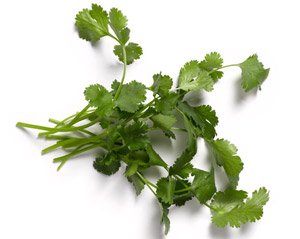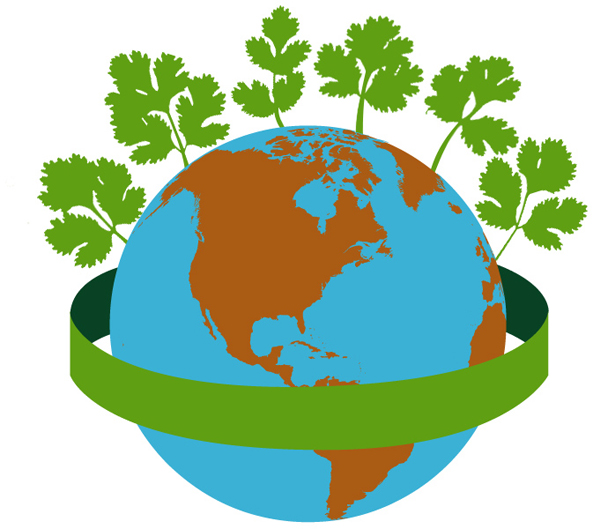
If you mapped cilantro’s use on a globe, it would look like an ever-widening green belt cinched around the earth’s stout belly. Known by the Spanish name for the leaves and stems of the coriander plant—from which the dried spice coriander (whole or ground seeds) is also derived—cilantro is among the world’s most popular herbs.
Although southern Europe, along the Mediterranean, is often credited as cilantro’s native land, there is disagreement among botanists as to the herb’s precise origins, and North Africa, India, and China have not been ruled out. Wherever the source may be, cilantro is most definitely an ancient Old World herb—it’s mentioned in Sanskrit and Egyptian texts, as well as the Old Testament—and it was an early vagabond along the overland and maritime spice routes through Europe, the Middle East, Asia, and Africa.
The Columbian Exchange brought cilantro to the southern reaches of the New World, where it became entrenched in Central and South American cuisines. The seeds hitchhiked to North America a century and a half later via the British colonists, whose ancestors were themselves introduced to the plant by the Romans. Yet it was only in the late 1970s and early ’80s that the globe-trotting herb began to hit its stride here: That’s when America’s palate got fired up for the spicy foods of Mexico, China’s Szechuan and Hunan provinces, and Thailand, all cuisines in which cilantro became best friends forever with its New World pal, chiles.
Thirty years ago, cilantro was not easy for home cooks to find, at least not on the East Coast. In New York City, you either went to Chinatown and asked for Chinese parsley, or you went to La Marqueta in East Harlem and asked for cilantro. Add fresh coriander to the list of names by which cilantro was labeled by food magazines and produce managers, and it’s no wonder it was confusing at first. Cilantro didn’t become a year-round regular in supermarkets nationwide until the beginning of the 21st century.
What really clinched cilantro’s popularity—and the dominance of its Spanish moniker—in the United States? Salsa. Factor in cilantro-studded guacamole, as well: Just as the demand for avocados peaks over Super Bowl weekend and Cinco de Mayo, sales of cilantro rise, too.
To get an idea of America’s appetite today for the lacy leaves, consider the data from Cal-Organic, one of the major U.S. producers of bunched cilantro. It alone harvests an average of 40 to 50 tons per week, according to Todd Brendlin, the company’s organic farming manager. “We do more cilantro than either Italian parsley or curly,” Brendlin explains, adding that sales are increasing five to ten percent each year.
Despite these impressive figures, cilantro doesn’t enjoy unconditional love in the United States. Rather, a significant number of people (many, it’s thought, of northern European descent) have a love/hate relationship with the herb. Either you can’t get enough of it, like me, or you’re repulsed by what’s often described as its soapy flavor.

The basis for these extreme reactions may be genetic. Scientists at the Monell Chemical Senses Center in Philadelphia found that cilantro contains a number of volatile chemicals that are the source of the delicious grassy-green aromas as well as the unappetizing soapy scent. Not everyone is able to detect the pleasant aspect of cilantro, so some people get only the full-on hit of soapiness, perhaps due to genetic mutations to our olfactory receptors. Even if your nose can’t get to the good side of cilantro, it’s possible to learn to appreciate it. Danielle Reed, Ph.D., a taste geneticist at the Monell Center, likens it to color blindness. Even if you’re color-blind and can’t see blue, she explained, you can still learn to appreciate art.
In another bit of coriander lore, etymology meets entomology: Many sources say that the word coriander comes from the early Greek word koris, for bug or bedbug. The funky aroma of the fresh seeds (when dried, that scent disappears) and leaves is thought to have reminded the Greeks of bedbug urine. And according to Australian spice expert Ian Hemphill, author of The Spice and Herb Bible, and Cornell University entomologist Cole Gilbert, there’s a basis for this, in a compound shared by bugs and cilantro known as dodecenal. Diana Kennedy, the doyenne of Mexican cooking, concurs, describing fresh cilantro’s aroma as “strong, rather like the juice of some edible beetles in Mexico.”
The insect connection has apparently not detracted from the herb’s importance in Mexico, and in India—one of the world’s biggest cilantro producers, consumers, and exporters—“the only complaint you’ll hear about cilantro is that there’s never enough in a dish,” says Julie Sahni, proprietor of Julie Sahni’s Indian Cooking School. She believes the aversion to cilantro, which she discovered only after starting to teach at her home in Brooklyn, can be overcome with steady exposure to it. I’ve seen that myself in a fellow recipe developer who despised cilantro initially but—within a year of frequently cooking with it—came not only to tolerate it but to like it. In cultures like India’s, where the herb is a staple, fetuses and nursing babies are no doubt conditioned to it via their mothers, Sahni maintains, citing research from the Monell Center.
Madhur Jaffrey, the Delhi-born award-winning actress and cookbook author, contends that cilantro’s vitamin value is one of the keys to its ubiquity in Indian cuisine. “There is a reason why everything is on the [Indian] table, and usually it’s medicinal and not just flavor,” Jaffrey explains. Cilantro is rich in antioxidants and dietary fiber, as well as potassium, calcium, and manganese. It’s packed with vitamin A and is one of the richest herbal sources of vitamin K, a deficiency of which may be linked to Alzheimer’s disease.
Between the seeds, leaves, stems, and roots, the coriander plant has been recognized since ancient times for its many medicinal applications, ranging from a digestive aid, diuretic, cough suppressant, and hemorrhoid treatment to overall Ayurvedic body balancer. The latest discovery regarding the plant’s benefits involves the essential oil extracted from the seeds. Researchers from the University of Beira Interior in Portugal—another country crazy for cilantro, according to Jean Anderson, author of The Food of Portugal—found that the oil can kill or retard the growth of a number of nasty bacteria, such as the food poisoning culprits E. coli and salmonella as well as MRSA (a strain of staphylococcus resistant to antibiotics), by attacking the membranes of the bacterial cells.
These represent just a few of cilantro’s virtues, and there are surely more to be discovered. With so much to recommend this herb and spice, chances are that even if you’re not a fan now, your children will be. That verdant belt of cilantro around the earth? It’s only going to get greener, and a whole lot wider.
Kemp Minifie was wrapped up in all aspects of food at Gourmet magazine for 32 years, and is now part of the Epicurious team.

